Spider Collector's Journal (31st page: 2021) Copyright © 2021 by Rod Crawford
Here's the 31st page of narratives of fun (and not so fun) trips to collect spiders for research at the Burke Museum, some accompanied by capable field volunteers: Laurel Ramseyer and new recruits. Most also appeared in Scarabogram, newsletter of "Scarabs: The Bug Society." Dates of field trips head each paragraph. Maps showing the location of sites within Washington state follow the grid system outlined in the Washington Spider Checklist. RETURN TO INDEX
Where you see this button ![]() in a
field trip account, click it to get a page of collecting site photos!
in a
field trip account, click it to get a page of collecting site photos!
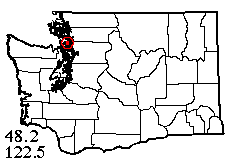 |
![]() 5 IV 2021: Early spring was finally becoming warm enough for spiders to move, and Della Scott now had access to Zipcars again, so we planned a short trip (the shortest remaining trip to an unsampled site) to northwestern Camano Island. April 5 proved to be a gorgeous day, and with only a couple of minor wrong turns, we reached the area of Odd Fellows Park, but couldn't find anything that looked like a park. I guess the rumor that the Odd Fellows were selling that property must have been true. First backup plan was the nearby trailhead of Camano Ridge Trail, which worked out fine. The preserve the trail goes through includes mature forest, but the area I needed to sample was clearcut in 2012 and had become too brushy for us to get very far from the parking lot and trail. However, one young maple tree had a beautiful accumulation of leaf litter, which I sifted for two hours or so, getting plenty of spiders and (as it turned out) a fine sample of 17 species including the species named for this island in 1954, Thymoites camano. Good thing I had such a great start, because the limited available moss added only one; conifers, salal and ferns only 6 or 7, plus one nice wolf spider in a small grass patch. But I had two more sites to try in this quarter of the island, so onward!
5 IV 2021: Early spring was finally becoming warm enough for spiders to move, and Della Scott now had access to Zipcars again, so we planned a short trip (the shortest remaining trip to an unsampled site) to northwestern Camano Island. April 5 proved to be a gorgeous day, and with only a couple of minor wrong turns, we reached the area of Odd Fellows Park, but couldn't find anything that looked like a park. I guess the rumor that the Odd Fellows were selling that property must have been true. First backup plan was the nearby trailhead of Camano Ridge Trail, which worked out fine. The preserve the trail goes through includes mature forest, but the area I needed to sample was clearcut in 2012 and had become too brushy for us to get very far from the parking lot and trail. However, one young maple tree had a beautiful accumulation of leaf litter, which I sifted for two hours or so, getting plenty of spiders and (as it turned out) a fine sample of 17 species including the species named for this island in 1954, Thymoites camano. Good thing I had such a great start, because the limited available moss added only one; conifers, salal and ferns only 6 or 7, plus one nice wolf spider in a small grass patch. But I had two more sites to try in this quarter of the island, so onward!
Finisterre Fitness Trail (one of those trails built as an adjunct to a housing development) looked like worthy habitat, but the access road was too-clearly marked private. However, a nearby sea-bluff viewpoint turned out to be public, Utsalady Point Park. Something of a pocket park (the whole thing visible from the 3-car parking lot) but with habitats (and a resident bald eagle) to be found. To begin with, I thought I was doing well getting 3 microspiders from 50 Douglas-fir cones, but two were juvenile and I already had the third. But I did add 4 more from shrubs, shore pine and salal, and some Douglas-firs down the road gave me a couple of nice salticids. End result, 30 species, a perfectly OK sample. We'd exhausted known sites too early to see a sunset.
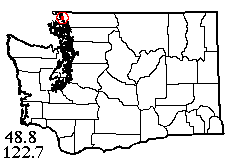 |
![]() 16 IV 2021: For our second Zip-trip, Della and I went to the Cherry Point area (coastal area W of Ferndale, site of a big oil refinery but otherwise rather undeveloped). Not a failure (I got 24 species) but certainly not very much for the effort involved, though we had a beautiful day for it! First, we stopped along Grandview Road so I could hike north along the railroad tracks and beat conifers. A success, but only 5 conifer-dwelling species (and those trees were farther apart than I'd thought), plus a Salticus scenicus active on the tracks. I swept the trackside field on my way back to the road, for only 2 species (at least there was a Xysticus). Little did I know how good that would soon look…
16 IV 2021: For our second Zip-trip, Della and I went to the Cherry Point area (coastal area W of Ferndale, site of a big oil refinery but otherwise rather undeveloped). Not a failure (I got 24 species) but certainly not very much for the effort involved, though we had a beautiful day for it! First, we stopped along Grandview Road so I could hike north along the railroad tracks and beat conifers. A success, but only 5 conifer-dwelling species (and those trees were farther apart than I'd thought), plus a Salticus scenicus active on the tracks. I swept the trackside field on my way back to the road, for only 2 species (at least there was a Xysticus). Little did I know how good that would soon look…
My next goal was a big field (with cottonwood forest fringe) at the intersection of Lonseth and Kickerville roads. This field looks lush and green in the July 2019 street view. Sere and dry for us! And around 20 minutes sweeping got me not one single spider! Also, just enough lurking blackberry to snag my net every few sweeps. At least cottonwood litter was fairly productive, but the spiders weren't as diverse as I thought. Practically no moss; what little I found was dry and produced no spiders. At all 3 sites, there was no access to understory (what I saw was pretty much all salmonberry interlaced with blackberry).
My last site was a well-hidden public beach at the south end of Gulf Road. A fine spot with a view of the San Juan Islands! The beach meadow, for a wonder, produced a reasonable sweep sample. The cobble beach had a few Pardosa lowriei, the large gravel bar wolf spider. (I'd got one P. metlakatla at Lonseth Road). Again, the forest practically impenetrable due to blackberry. Just behind the beach meadow was solid wild rose. Nothing under the driftwood. Leaf litter back of the roses was full of ants, but still added a species. Toward the end, just before Della got too tired to continue, I found a gap in the roses that gave me access to the marsh zone behind the beach, where I got in some more sweeping and found what I hoped would be a third Pardosa (but it was juvenile). At the very end of my time, there was some gorgeous conifer foliage I was hoping to access, but when I got close I found it was too marshy between me and the tree. Oh well, another spot filled in on my map.
 |
![]() 15 V 2021: Time for another Zipcar trip with Della! This time we went south to a site Laurel and I had failed to find back in 2019: a clearcut and riparian zone on Port Blakely Tree Farm land, on the east side of Bush Creek valley west of McCleary (along the Olympia-Ocean Beaches highway). This time, with better directions, we found our parking spot without trouble. The gated road I'd planned to hike did exist, but was grass-grown and clearly unused. A pleasant walk (but for one downed tree) later, we intersected a newer logging road leading to the clearcut. Della rested in the shade with her crossword while I hiked on up to sample clearcut fauna. Almost the first thing I got was rare-in-Washington Cyclosa turbinata. However, that was almost the only rarity in the clearcut, not as rich in prairie fauna as not-far-off Lost Prairie. Sweeping, beating broom (present only sporadically), one active wolf spider and beating the young conifers got me 17 species including uncommon Clubiona kastoni. Meanwhile, back at the trail-road intersection Della found Cyclosa conica, allowing me to contrast the two species' habitats.
15 V 2021: Time for another Zipcar trip with Della! This time we went south to a site Laurel and I had failed to find back in 2019: a clearcut and riparian zone on Port Blakely Tree Farm land, on the east side of Bush Creek valley west of McCleary (along the Olympia-Ocean Beaches highway). This time, with better directions, we found our parking spot without trouble. The gated road I'd planned to hike did exist, but was grass-grown and clearly unused. A pleasant walk (but for one downed tree) later, we intersected a newer logging road leading to the clearcut. Della rested in the shade with her crossword while I hiked on up to sample clearcut fauna. Almost the first thing I got was rare-in-Washington Cyclosa turbinata. However, that was almost the only rarity in the clearcut, not as rich in prairie fauna as not-far-off Lost Prairie. Sweeping, beating broom (present only sporadically), one active wolf spider and beating the young conifers got me 17 species including uncommon Clubiona kastoni. Meanwhile, back at the trail-road intersection Della found Cyclosa conica, allowing me to contrast the two species' habitats.
The beautiful lush riparian zone was irresistible, and sweeping roadside grass added 9 species. Fern understory close to the road brought me to 32. Now, I should have stayed right where I was for litter and moss sifting but I had a plan — to continue along the grassy former road to the East Fork of Bush Creek where the aerial photos show lush, mesic valley maple stands. But the road had other ideas, and petered out in alder swamp within 1/4 mile. So I did my sifting there: swamp alder litter added only 4 species (but included rare Scironis tarsalis); dry moss did have a few spiders but added no species.
I now hoped to get some house spiders at the Grays Harbor County Fairgrounds east of Elma. We drove all around the grounds but couldn't seem to find a road going in! Finally we parked on a dirt road called Filly Lane beside the Elma Oddfellows Cemetery, where I added a couple more for 38 species total.
 |
![]() 22 V 2021: Finally, after a 14-month hiatus, Laurel and I being now fully vaccinated, we could resume doing field trips together! Our goal this first time was a potentially lovely site in Mason County called Deer Meadow. We navigated the forest roads to within three miles of the site, then curses, a locked gate! Having just driven a long ways, Laurel didn't feel much like hiking three miles, so I pulled out an alternative plan a few miles to the southwest along Fir Creek. This proved easy to find and right along main forest road 23.
22 V 2021: Finally, after a 14-month hiatus, Laurel and I being now fully vaccinated, we could resume doing field trips together! Our goal this first time was a potentially lovely site in Mason County called Deer Meadow. We navigated the forest roads to within three miles of the site, then curses, a locked gate! Having just driven a long ways, Laurel didn't feel much like hiking three miles, so I pulled out an alternative plan a few miles to the southwest along Fir Creek. This proved easy to find and right along main forest road 23.
On arrival, this accessible site (and the fair weather) seemed practically perfect. Right beside the road was a small meadow where I easily swept 8 species, while numbers of Pardosa vancouveri zipped around at my feet. Laurel meanwhile had good sifting with the streamside tree trunk moss across the road, for 11 species not taken otherwise, including very rare Dictyna olympiana. From our parking spot, a blocked gravel track led up into a spider-rich clearcut, where I beat 15 species from conifer foliage and found two spectacular Habronattus jumping spider species (and a second Pardosa) active on the rocky substrate. Later on, Laurel visited this clearcut and turned over the charred wood in a fire ring, adding a third wolf spider plus a Crustulina and a Callilepis.
While I sifted leaf litter (adding 9 more species), Laurel hiked up the road to a second site where she accessed gravel bars along the creek. Under the stones she found Saaristoa, Walckenaeria (with egg sac) and two Bathyphantes species, one the rare B. malkini. Each of us added one more species from forest understory. On the road homeward (Laurel with one Ozyptila to rear [successfully]) we had a very fine 47 species!
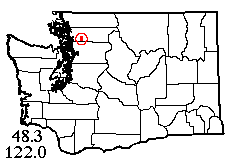 |
![]() 30 V 2021: For our second trip, Laurel and I took the relatively short drive up Lake Cavanaugh Road to a private (but open to hikers) logging road that crosses Lake Creek and eventually climbs a less-than-2000' hill grandiosely styled Mount Cavanaugh. First I swept in a recent grassy clearcut, getting 9 species; Laurel meanwhile was sifting some moss and litter by a tiny creek back in the woods nearby, getting a significant number of species but only one we didn't take elsewhere. However, the litter contained a redbacked salamander! I found 3 species active in the clearcuts (a little one was satellite to the big one) and beat several from hemlock foliage.
30 V 2021: For our second trip, Laurel and I took the relatively short drive up Lake Cavanaugh Road to a private (but open to hikers) logging road that crosses Lake Creek and eventually climbs a less-than-2000' hill grandiosely styled Mount Cavanaugh. First I swept in a recent grassy clearcut, getting 9 species; Laurel meanwhile was sifting some moss and litter by a tiny creek back in the woods nearby, getting a significant number of species but only one we didn't take elsewhere. However, the litter contained a redbacked salamander! I found 3 species active in the clearcuts (a little one was satellite to the big one) and beat several from hemlock foliage.
Just to see what we could see, we continued up the road to the flank of the "mountain", where we finally found a small stand of bigleaf maple. I sifted maple litter and Laurel did some more moss, getting no spiders not found elsewhere, but her beating ferns on a roadside bank was valuable, with 2 Bathyphantes species among others. Returning down the road, we stopped at a pile of rocks just on the off chance that there might be some spiders under them. This was the big bonus of the trip, adding 6 species including 3 female Porrhomma convexum, good to see.
Finally, we settled down to some serious sifting back at the gated bridge near where we'd parked. Both moss and litter at this site added species, and so did Laurel's scanning the bridge itself. Although none of the habitats here was unusually rich, every little bit helped and we equaled our last week's catch with 46-49 species!
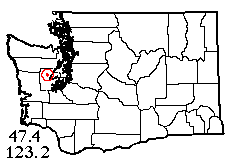 |
![]() 4 VI 2021: This time, the full triumvirate (Laurel, Jerry and I) used a revised route and actually reached Deer Meadow, which we didn't get anywhere near on May 22. That is, we sort of reached it! Parking just inside the national forest, we had a brief chat with a backwoods bozo ("Spiders? I hate spiders! They bite!"), then hiked a blocked but not-long road through a Green Diamond clearcut into a good-sized tract of City of Tacoma property adjacent to Upper Cushman Dam. The place called Deer Meadow on the map was just right of the road, down a very steep, brushy slope, and looked wet! A little beyond the "real" Deer Meadow, the road went directly to a large tract of grass with flowers and logs and young conifers, altogether a collectors' paradise. While Laurel backtracked in search of cones and moss, Jerry and I went our separate ways, both (as it turned out) intent on sweeping grass and beating conifer foliage. The sweeping was great and got 17 species, only 5 of them taken by both sweepers. The conifer beating was beyond great and produced 27 species, a full sample all by itself! Of the 27, only 10 duplicated the sweep sample and 11 were taken by both of us, 16 by only one or the other. I added 2 species by beating broom and Jerry found 3 more under wood. Adding an active Pardosa, we now had 40 species just from this grassy tract!
4 VI 2021: This time, the full triumvirate (Laurel, Jerry and I) used a revised route and actually reached Deer Meadow, which we didn't get anywhere near on May 22. That is, we sort of reached it! Parking just inside the national forest, we had a brief chat with a backwoods bozo ("Spiders? I hate spiders! They bite!"), then hiked a blocked but not-long road through a Green Diamond clearcut into a good-sized tract of City of Tacoma property adjacent to Upper Cushman Dam. The place called Deer Meadow on the map was just right of the road, down a very steep, brushy slope, and looked wet! A little beyond the "real" Deer Meadow, the road went directly to a large tract of grass with flowers and logs and young conifers, altogether a collectors' paradise. While Laurel backtracked in search of cones and moss, Jerry and I went our separate ways, both (as it turned out) intent on sweeping grass and beating conifer foliage. The sweeping was great and got 17 species, only 5 of them taken by both sweepers. The conifer beating was beyond great and produced 27 species, a full sample all by itself! Of the 27, only 10 duplicated the sweep sample and 11 were taken by both of us, 16 by only one or the other. I added 2 species by beating broom and Jerry found 3 more under wood. Adding an active Pardosa, we now had 40 species just from this grassy tract!
Meanwhile, Laurel tapped a set of 100 Douglas-fir cones, adding only 2 species but one of those was a brand-new Euryopis, unlike anything I'd ever seen but closely related to the eastern E. argentea. She also added 5 more species from forest tree moss, and 4 more from another batch of moss back at the clearcut edge. She and Jerry both (at different points) bravely scrambled down to the edge of the "real" Deer Meadow. One step out, and their feet sank! So the "meadow" that was really a marsh went unsampled, but Spiraea shrubs at the edge added 3 more species for Laurel.
Up above the marsh, there was plentiful understory (ferns, salal, etc.) hanging down the road bank, which I beat, adding a few. A brief maple litter sift added 6 nice ones including a lovely adult female of the weird Rhomphaea fictilium. Counting an Ozyptila Laurel is rearing, our phenomenal total for the day is 65 species!
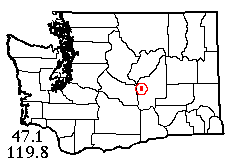 |
![]() 11 VI 2021: The following week was wet west of the Cascades, but I let Laurel know an eastern-Washington trip was possible. On Thursday, she told me she could go on Friday, when the only dry predictions were for way out past Vantage. But I was up for it if she was! We successfully reached Road 3 and drove down it to the east end of Burke Lake at the extreme edge of our grid-area, where we got 5 species in and around an outhouse. Then back east to slightly wilder Flat Lake, which we reached by a fairly short cross-country walk with a few too many cheat-grass seeds lying in wait for our socks!
11 VI 2021: The following week was wet west of the Cascades, but I let Laurel know an eastern-Washington trip was possible. On Thursday, she told me she could go on Friday, when the only dry predictions were for way out past Vantage. But I was up for it if she was! We successfully reached Road 3 and drove down it to the east end of Burke Lake at the extreme edge of our grid-area, where we got 5 species in and around an outhouse. Then back east to slightly wilder Flat Lake, which we reached by a fairly short cross-country walk with a few too many cheat-grass seeds lying in wait for our socks!
Laurel and I both swept the green riparian semi-marsh near the lake, getting exactly the same 7 species. She also swept the dry grass and herbs nearer the road, adding 6 more including one specimen each of adult Erigone and Metepeira. We also both sampled the abundant dictynids making webs and retreats on dead plant tips. Between this and sweeping, it appears we got around 7 Dictyna species, though I won't swear to the count since those females are hard to distinguish in a quick run-through. Laurel got the day's only flower crab spiders, Misumenops lepidus, by beating milkweed. I sifted grass litter, getting a couple of interesting juveniles: a Castianeira and an Argiope. Sagebrush shrubs were a bit sparse, but produced a quite nice 7-species spider fauna.
On our way back to the highway, we stopped at the bridge over West Canal where Laurel checked the railings and I, under the ends (plastered with swallow nests) for webs. Two species were juvenile, and the only adults taken were two additional species of Dictyna! A light rain sprinkle brought on a fine rainbow. A last, brief stop at a pond by Road 2 added two very interesting pioneer species under rocks, including the third Washington record of Eurasian jumping spider Attulus ammophilus. Day's total, 29 species.
 |
![]() 17 VI 2021: Way back near the beginning of 2020, Laurel had made contact with Natalie Jones of the Green River Watershed, a very big tract of restricted territory between the Cedar River on the north and White River on the south, preserved for the Tacoma city water supply. Without much trouble, we arranged access for spider collecting; but things happened (like a pandemic in the spring and lousy weather in the fall) so only now, nearly a year and a half later, did the plan bear fruit. After a relatively short drive we met Natalie at the watershed gate and transferred to her giant pickup for the watershed logging roads (where CB communication is required, one amenity Laurel's Prius doesn't have!). Before too long we were on a grassy logging road skirting the north side of remote Little Eagle Lake.
17 VI 2021: Way back near the beginning of 2020, Laurel had made contact with Natalie Jones of the Green River Watershed, a very big tract of restricted territory between the Cedar River on the north and White River on the south, preserved for the Tacoma city water supply. Without much trouble, we arranged access for spider collecting; but things happened (like a pandemic in the spring and lousy weather in the fall) so only now, nearly a year and a half later, did the plan bear fruit. After a relatively short drive we met Natalie at the watershed gate and transferred to her giant pickup for the watershed logging roads (where CB communication is required, one amenity Laurel's Prius doesn't have!). Before too long we were on a grassy logging road skirting the north side of remote Little Eagle Lake.
I hiked ahead and swept a small clearing, while Laurel and Natalie stayed on the shady stretch of road and swept many more (but different) species from roadside grass. The sweeping alone got 22 species! I got one wolf spider species in the clearing and Laurel got another in semi-shade. My main idea for this site was to beat conifer foliage, but most of that was high above my head, leaving only alder within reach of the road. Still, I found some and added a few more species. Laurel and Natalie skidded down through the steep forest to the unspoiled and gorgeous lake shore. This excursion added only 6 species, but one (Laurel's catch of the day) was rare Tetragnatha elongata.
The "catch" of this trip was that Natalie had to be back at headquarters by 3:30. So we drove around to the other side of the lake and wormed our way through jungle-like understory into a dense forest of bigger alders beside the outlet stream. We each gathered two huge bags full of sifting-stuff (Laurel got moss, I got litter). While there, we each added one more species from vegetation. Then, we picked a nice shady spot down the road from the gate, Natalie dropped off the bags (carrying those over rough terrain was a struggle), and we spent the next 2 hours sifting! To good effect though, as each habitat added its own suite of species and the bottom line for Little Eagle Lake was a phenomenal 51 spider species! Having extra hands does help…
 |
![]() 25 VI 2021: When I learned of Damon Point, extensive vegetated sand island connected by a narrow spit to the Ocean Shores peninsula, it seemed likely to be an ultra-cool habitat with interesting spiders. Laurel thought so too. We ended up going there on the eve of a historic heat wave (it was one of a few places predicted to be cooler). Not quite as cool as predicted, as it happened, but livable. Anyway, we walked toward the point, partly using a not-so-old paved road that winter waves had partly destroyed. Seeing what looked like a few trees in the expanse of hot grass and broom, we found a small grove of stubby but shade-giving alders. Of course I tried sifting litter, but found no spiders. Then I got a few species from shrubs (this vial somehow disappeared before I got home). Laurel got a nice 6 species sweeping the sandy meadow, to which I added one. Broom produced one species and a harvestman. Laurel made a short excursion to the protected north beach of the peninsula, where just one of the spiders she found under driftwood (a Phidippus) was mature.
25 VI 2021: When I learned of Damon Point, extensive vegetated sand island connected by a narrow spit to the Ocean Shores peninsula, it seemed likely to be an ultra-cool habitat with interesting spiders. Laurel thought so too. We ended up going there on the eve of a historic heat wave (it was one of a few places predicted to be cooler). Not quite as cool as predicted, as it happened, but livable. Anyway, we walked toward the point, partly using a not-so-old paved road that winter waves had partly destroyed. Seeing what looked like a few trees in the expanse of hot grass and broom, we found a small grove of stubby but shade-giving alders. Of course I tried sifting litter, but found no spiders. Then I got a few species from shrubs (this vial somehow disappeared before I got home). Laurel got a nice 6 species sweeping the sandy meadow, to which I added one. Broom produced one species and a harvestman. Laurel made a short excursion to the protected north beach of the peninsula, where just one of the spiders she found under driftwood (a Phidippus) was mature.
I had high hopes for an apparent stand of shore pine in mid-island, seen on a 2016 aerial photo. (We really weren't supposed to go there according to some websites, due to nesting of a threatened bird, but I didn't know that at the time; we saw no such warning on signs, and saw no birds on site). But the bigger pines that might have had conifer foliage spiders were all gone! Nothing but stumps and "baby" trees of about breast height, that had only more meadow spiders. What happened here? A timber harvest? Habitat management for birds? A fire? I haven't found a clue to the mystery. This short excursion added one species, making 10 for Damon Point. Fortunately, we had more strings to our bow.
After visiting a storage building for house spiders (adding only one species not taken elsewhere), we stopped at Weatherwax Nature Preserve on the east side of Ocean Shores, which has a public trail through it and consists of spruce-alder forest with salal-dominated understory. Since I'd brought gloves, I was able to beat prickly spruce foliage for a very good sample. Laurel and I both beat salal, adding several good ones, and she boosted the sample by three more by sweeping grass in the shade. She found nothing in moss here, but our end result was a satisfactory 28-29 species. I also had an old Tegenaria from an Ocean Shores resident!
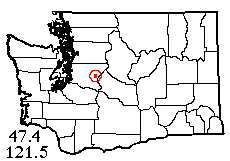 |
![]() 8 VII 2021: The trail to Talapus Lake (in the mountains some 5 miles west of Snoqualmie Pass) has the most foot traffic, even on a weekday, of any trail I can remember. At the lake (still reasonably pretty), the very chipmunks are so used to people, they beg like dogs and try to sneak into your pack! Spider-wise, the best part of the trip was a white pine tree Laurel found half-way up. She tapped 100 pine cones there, getting 6 spider species; found 2 more good ones (native orbweavers) in aerial webs; and added a good crab spider from understory. I continued to the lake and was hoping to make my way up the east side (bypassed by the trail) to a more meadow-like habitat at the north end, but never got very far in the maze of unofficial foot-routes. I found some dead wood to tap, but added no species. All this time I could hear the voices of hikers somewhere just out of sight! Finally I stumbled on a little clearing formed by talus, where I got 8 species from shrubs, herbs and a few small conifers. At this point, Laurel called me by cell phone to suggest rejoining forces.
8 VII 2021: The trail to Talapus Lake (in the mountains some 5 miles west of Snoqualmie Pass) has the most foot traffic, even on a weekday, of any trail I can remember. At the lake (still reasonably pretty), the very chipmunks are so used to people, they beg like dogs and try to sneak into your pack! Spider-wise, the best part of the trip was a white pine tree Laurel found half-way up. She tapped 100 pine cones there, getting 6 spider species; found 2 more good ones (native orbweavers) in aerial webs; and added a good crab spider from understory. I continued to the lake and was hoping to make my way up the east side (bypassed by the trail) to a more meadow-like habitat at the north end, but never got very far in the maze of unofficial foot-routes. I found some dead wood to tap, but added no species. All this time I could hear the voices of hikers somewhere just out of sight! Finally I stumbled on a little clearing formed by talus, where I got 8 species from shrubs, herbs and a few small conifers. At this point, Laurel called me by cell phone to suggest rejoining forces.
Finishing with my little clearing, I tried to follow Laurel's directions to meet her, but never found her. I went as far as the bridge over Talapus Creek (south of the lake) and up the west side, then tried calling but could get no signal! Laurel, whom the satellites liked better than me, finally called back and we met at the bridge. She had been collecting from dead wood on the east side not too far from me (but out of sight and hearing), and after much effort added only 2 species to her previous pine cone sample. She did some creekside sweeping (adding one jumping spider species), while I sampled a lovely pile of reddish wood chunks (duplicating what we already had), and we called it a day with 20 species. Fortunately, an old orbweaver record from Pratt Lake and a not-so-old moss sample near Bandera supplemented this to an adequate 26.
Why didn't we do better? Well, much of the terrain we visited was sparsely vegetated at ground level. No deciduous litter, no siftable moss, very little reachable conifer foliage, and we just didn't stumble onto the better habitats that no doubt existed nearby. Some of the forest was mature, but not the kind of old growth that has deep, productive needle litter and a rich scatter of dead wood. Perhaps I'd have done better if I'd gone straight up the west side of the lake to the extensive boulder talus we could see from across the water…
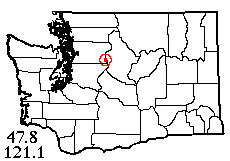 |
![]() 16 VII 2021: Midsummer is the time to collect in the mountains, and I had a trip plan for the Rapid River, a third-order tributary coming within two miles of the Cascade Crest but reached by a driveable road. The road wasn't even as bad as expected, but has been decommissioned a ways short of its original end, still across the border of the area we wanted to sample. We parked in an apparent gravel pit (but the sides were more soil than gravel), near the confluence of the Rapid River's north fork crossed by an interesting curved bridge. A trail continues up the former road, initially through alder, with an occasional trickle tributary furnishing moisture.
16 VII 2021: Midsummer is the time to collect in the mountains, and I had a trip plan for the Rapid River, a third-order tributary coming within two miles of the Cascade Crest but reached by a driveable road. The road wasn't even as bad as expected, but has been decommissioned a ways short of its original end, still across the border of the area we wanted to sample. We parked in an apparent gravel pit (but the sides were more soil than gravel), near the confluence of the Rapid River's north fork crossed by an interesting curved bridge. A trail continues up the former road, initially through alder, with an occasional trickle tributary furnishing moisture.
I swept grass and herbs around our parking pit and along the roadside for six species, then beat conifer foliage (reachable only here and there) for another four. Laurel sifted six from moss on alder trunks, and got the day's best sample from the bridge railings, 9 species including mature Novalena intermedia, Zygiella dispar and Araneus gemma. We never did get down to the actual Rapid River (a long ways down and none too close to the road), but I found a route down to the North Fork and added three species in riparian understory, to which Laurel later added an atypical Clubiona pacifica in its leaf retreat. She got Neriene litigiosa in its dome web, nothing mature under river rocks, and nothing different from understory of an upland alder grove. My sifting of alder litter added the last three, for 27 species in all.
Although not super-productive, it was a pleasant day in attractive and nicely varied surroundings, not too hot under a mostly-cloudy sky, and nicely people-free; only one other car visited (very briefly) our end of the road. As usual on Stevens Pass Highway trips, we dined at Zeke's Drive-in.
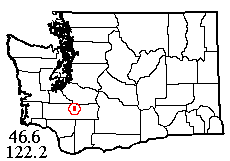 |
![]() 22 VII 2021: Needing to fill in records in central Lewis County, I selected sites on and near East Creek, within that outlier of the Cascades west of Highway 7 and belonging to the National Forest system but rarely mentioned as such. We (Laurel, Jerry Austin and I) started on a ridge crest that appeared to have a series of rocky balds. And sure enough, it did! The first bald was right above the road and slanted at quite a steep angle (see album) but not hard to climb; the ground cover is moss and beargrass with assorted cool rocky-habitat herbs. Conifer foliage around the edges gave me 6 species including a nice female Pityohyphantes alticeps. Laurel followed behind me sweeping the beargrass and huckleberry (ripe, yum yum) but added only one species.
22 VII 2021: Needing to fill in records in central Lewis County, I selected sites on and near East Creek, within that outlier of the Cascades west of Highway 7 and belonging to the National Forest system but rarely mentioned as such. We (Laurel, Jerry Austin and I) started on a ridge crest that appeared to have a series of rocky balds. And sure enough, it did! The first bald was right above the road and slanted at quite a steep angle (see album) but not hard to climb; the ground cover is moss and beargrass with assorted cool rocky-habitat herbs. Conifer foliage around the edges gave me 6 species including a nice female Pityohyphantes alticeps. Laurel followed behind me sweeping the beargrass and huckleberry (ripe, yum yum) but added only one species.
The next bald uphill was flatter, and in between was a forest belt with a few dead-wood species. Vegetation here had much the same spiders as the larger, steeper bald below, but it was defnitely a pleasant place to eat lunch! At one point Laurel must have stepped on the wrong spot, causing 3 adolescent rabbits to pop up out of a burrow and make tracks! Laurel had been tapping Douglas-fir cones (getting one spider), and also got a good Calymmaria under a rock. Meanwhile, Jerry had been sweeping roadside foliage and got 4 species we didn't. For a relatively short visit, 15 species at the balds wasn't bad at all.
We were planning to get the bulk of our collection at a lower site in the riparian zone of East Creek. Here, Jerry added two species from the roadside, I got two more from riparian understory, and sifting very sparse litter added only one to what we had from dead wood at the higher site. Jerry got one more good record from lower elevation dead wood, Laurel added two from moss, and I added one from roadside hemlock foliage. Slow going! Unfortunately, Laurel stepped on a concealed hole by the creek and twisted her ankle rather seriously. In all, 9 added to our first site's 15 made an unspectacular but sufficient 24 species. We did get a magnificent view of Mt. Rainier; also ripe salmonberries, even more delicious than huckleberries…
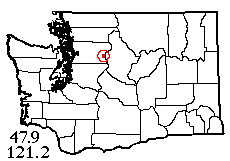 |
![]() 29 VII 2021: Laurel had to rest her ankle this week, but fortunately Jerry's car was finally fixed and we were able to head for a hiking destination: Quartz Creek Trail, up the North Fork Skykomish River. The plan was to get low-elevation species at the trailhead (shared with two other trails) and then hike up to a moderate elevation and collect in the old growth. The trailhead grass, herbs and conifers had nothing unusual but gave us a very welcome head start of 13 species. Then off up the trail, accompanied by a lot of unwelcome deer flies but not too many mosquitos.
29 VII 2021: Laurel had to rest her ankle this week, but fortunately Jerry's car was finally fixed and we were able to head for a hiking destination: Quartz Creek Trail, up the North Fork Skykomish River. The plan was to get low-elevation species at the trailhead (shared with two other trails) and then hike up to a moderate elevation and collect in the old growth. The trailhead grass, herbs and conifers had nothing unusual but gave us a very welcome head start of 13 species. Then off up the trail, accompanied by a lot of unwelcome deer flies but not too many mosquitos.
The trail (not used much until recently due to a road washout, newly repaired) was in excellent condition; but at one point a roughly-one-ton boulder had fallen from some unknown source and landed square on the trail! I forgot to take a picture, thus the stock photo of a much bigger boulder in the album. I kept finding spots with fairly good dead-wood habitat, but the "grass was always greener" around the next bend. Finally at 4:00 pm, I had to start collecting or run out of time. Jerry went on in search of better access to the nearby stream. As it turned out, I'd picked a good spot and eventually got 45 dead-wood specimens of 9 species, plus adding Microlinyphia dana from trailside understory. Moving back down the trail, the dead wood was much less productive!
Jerry caught up as I was working my way back down the trail. He'd found his stream access but hadn't added much, and found nothing under rocks, but got a magnificent Araneus gemma orbweaver on streamside trees. As it turned out we needn't have been so concerned about losing daylight, for we still had an hour or so of light when we got back to the car; which had mercifully cooled down after its afternoon in the sun. We took 22 species in all, not a tremendous sample but enough. We saw no one else on the trail.
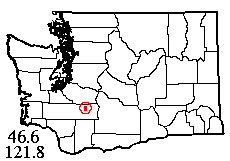 |
![]() 9 VIII 2021: This time Jerry was a little too bunged up to hike, so Laurel and I headed for Cora Lake in the mountains SW of Mt. Rainier. For a preliminary lowland sample, we stopped at nearby Berry Creek which has some mature forest in its canyon. I swept and beat 8 species along the spur road while Laurel found a short trail down into the canyon, where she got two more from trees, two under stream cobbles, and two unusual ones (one the uncommon Microhexura) from streamside moss. Under a piece of cardboard at our parking spot was the trip's only adult wolf spider. Total so far, 15 species.
9 VIII 2021: This time Jerry was a little too bunged up to hike, so Laurel and I headed for Cora Lake in the mountains SW of Mt. Rainier. For a preliminary lowland sample, we stopped at nearby Berry Creek which has some mature forest in its canyon. I swept and beat 8 species along the spur road while Laurel found a short trail down into the canyon, where she got two more from trees, two under stream cobbles, and two unusual ones (one the uncommon Microhexura) from streamside moss. Under a piece of cardboard at our parking spot was the trip's only adult wolf spider. Total so far, 15 species.
The trail to Cora Lake is easy and fun. Much of it goes through splendid old growth, and there are two stream crossings through a thin water film that (in summer) doesn't get the socks wet. We were alone at the beautiful lake, where I got 8 species (including another Microhexura) from dead wood; I really had to work to get them though! Laurel added 3 from lakeshore conifers, found Poeciloneta lyrica on a tree trunk and Poecilochroa montana active on the shore. Conifer litter and trunk moss had a few spiders, but nothing different. The lake was swarming with countless throngs of tadpoles!
We started down early enough to do a bit more collecting at the trailhead. Arrived there, I sifted some alder litter found across the road from the car, and surprisingly added 4 species including an undetermined Cybaeopsis. Laurel swept Misumena in a bog meadow, where I sifted an Erigone from bog moss. Our total for the area was 33 species, far better than we'd hoped.
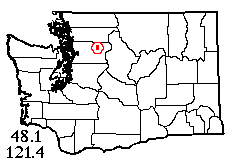 |
![]() 19 VIII 2021: Our goal, determined by a coin toss, was Peek-a-Boo Lake (or at least the trail leading to it), south of Darrington. Before going far along the 5.6-mile, narrow dirt road to the trailhead, we stopped for a low elevation (1000') sample in the floodplain of the Sauk River. Laurel sifted abundant tree trunk moss (7 spider species) while I swept roadside (5), beat understory (another 4) and sifted maple litter (3, plus centipedes, harvestmen and isopods). Laurel got the only mature Metellina in an aerial web, making 20 in all; not quite enough for a full sample! It was a peaceful place; we saw only one car, and no one on the trail.
19 VIII 2021: Our goal, determined by a coin toss, was Peek-a-Boo Lake (or at least the trail leading to it), south of Darrington. Before going far along the 5.6-mile, narrow dirt road to the trailhead, we stopped for a low elevation (1000') sample in the floodplain of the Sauk River. Laurel sifted abundant tree trunk moss (7 spider species) while I swept roadside (5), beat understory (another 4) and sifted maple litter (3, plus centipedes, harvestmen and isopods). Laurel got the only mature Metellina in an aerial web, making 20 in all; not quite enough for a full sample! It was a peaceful place; we saw only one car, and no one on the trail.
The recently repaired road to the trailhead is very narrow and brushy, but didn't scratch the car much. Good thing we met no other cars in passage! The trail led us through a stretch of seral forest before entering spectacular old growth, just what I was hoping for. Having gained some elevation, I stopped at a place with several good deposits of dead wood chunks, and spent the rest of my time tapping these over my net for a nice harvest of 50 spider specimens (with 9 identifiable species, including a nice male Arcuphantes arcuatulus). Laurel added three from trailside foliage and found three more good ones under rocks, unusual for western Washington. For the second trip in a row, when we headed back to the car we had 33 species! The trip down was enlivened by encounters with a barred owl and a ruffed grouse (see album). We dined at the Burger Barn, now open until 8PM again.
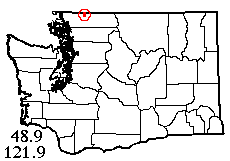 |
![]() 29 VIII 2021: This time, we went for a fairly-high site (3500') that we could reach by car: West Church Ridge, north of Mt. Baker Highway and just west of much higher Church Mountain, which is in an already-sampled area. The sunny day wasn't quite as cool as predicted, but far from oppressive and the habitats had received some very welcome rain. To get our lower-elevation head start, we started at Douglas Fir Campground on the highway. Laurel was in hog heaven because of the abundant moss on riparian trees. Sifting moss on trunks, logs and stumps produced 6 species, and "clods" of moss fallen from high limbs added 5 that were different, including the long-sought Ozyptila pacifica! I added one from the outhouse, four from understory and four from maple litter. We now had a fine head start of 19 spider species.
29 VIII 2021: This time, we went for a fairly-high site (3500') that we could reach by car: West Church Ridge, north of Mt. Baker Highway and just west of much higher Church Mountain, which is in an already-sampled area. The sunny day wasn't quite as cool as predicted, but far from oppressive and the habitats had received some very welcome rain. To get our lower-elevation head start, we started at Douglas Fir Campground on the highway. Laurel was in hog heaven because of the abundant moss on riparian trees. Sifting moss on trunks, logs and stumps produced 6 species, and "clods" of moss fallen from high limbs added 5 that were different, including the long-sought Ozyptila pacifica! I added one from the outhouse, four from understory and four from maple litter. We now had a fine head start of 19 spider species.
The road to the ridge crest had a few rough spots, but wasn't too bad. The clearing at the summit is maintained for a weather station, whose structures had introduced Araneus diadematus and Salticus scenicus. I swept 5 from fireweed and Anaphalis, and beat a further four from conifers at the clearing edge. Meanwhile, along the shady road back to where we'd parked, Laurel found an adult Misumena in her egg retreat, a male Clubiona in a leaf roll, and several giant Araneus nordmanni in their webs. I tried tapping dead wood in the one patch of mature forest that had any, adding only two species. Broken-rock habitat here and there provided a home for a pika, which squeaked at Laurel. The best news on the ridge crest was a little grove of cottonwood I'd noticed on the way up. Its leaf litter gave me 9 species from a single bag-full, adding 5 for a wonderful 40-species total!
 |
![]() 13 IX 2021: Weather and minor injuries forced us to skip a week, but we expected good results two weeks after our great West Church Ridge sample. Were we surprised! Laurel wanted to try the Surprise Creek Trail between Skykomish and Stevens Pass. A beautiful trail for sure, good hiking, essentially no biting insects. One disadvantage, the trailhead was not in the gridspace so we had to gain altitude before we could usefully collect. We started in an old growth tract just before a log bridge across Surprise Creek that had me a little spooked. I began by beating conifers and got a fine sample of 12 species, including both sexes of Poeciloneta fructuosa and other goodies. Things were looking good! Then Laurel sifted moss at the site; none at all of the many moss-specific species, and only three common spiders added. I thought I could surely get a good dead-wood sample, but it seems as if when you are below 3000' elevation the wood is unproductive. Lots of wood to tap, but added only one species, Cybaeus eutypus. At least, for a change, it wasn't the super-common C. reticulatus! At a site a couple hundred meters to the north, lots more wood, no more species; Laurel later tried sweeping gravel bar foliage, adding nothing. Total from the area, a mere 16 species.
13 IX 2021: Weather and minor injuries forced us to skip a week, but we expected good results two weeks after our great West Church Ridge sample. Were we surprised! Laurel wanted to try the Surprise Creek Trail between Skykomish and Stevens Pass. A beautiful trail for sure, good hiking, essentially no biting insects. One disadvantage, the trailhead was not in the gridspace so we had to gain altitude before we could usefully collect. We started in an old growth tract just before a log bridge across Surprise Creek that had me a little spooked. I began by beating conifers and got a fine sample of 12 species, including both sexes of Poeciloneta fructuosa and other goodies. Things were looking good! Then Laurel sifted moss at the site; none at all of the many moss-specific species, and only three common spiders added. I thought I could surely get a good dead-wood sample, but it seems as if when you are below 3000' elevation the wood is unproductive. Lots of wood to tap, but added only one species, Cybaeus eutypus. At least, for a change, it wasn't the super-common C. reticulatus! At a site a couple hundred meters to the north, lots more wood, no more species; Laurel later tried sweeping gravel bar foliage, adding nothing. Total from the area, a mere 16 species.
During the bulk of the time I was vainly tapping wood, Laurel braved the log and hiked a little farther south (up) to a meadow area. There she beat more conifers, adding nothing new, and swept bracken in the meadow, hoping for different species. There were two additions, one specimen each. The last hope was a net-full of huckleberry-bush litter that had accumulated in a rock crevice, brought back to the main site to sift. Only 5 or 6 specimens, and at least three more species needed to make 21. Well, the three were there! Ceratinops inflatus, Walckenaeria columbia and Agyneta protrudens, we salute you! 'Twas a narrow squeak indeed with the bare-minimum 21-species sample. We ended the trip with a refueling stop at Zeke's.
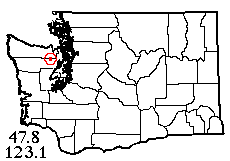 |
![]() 21 IX 2021: After another rainy spell, Laurel wanted to try an Olympic Peninsula site, so we went south from Sequim Bay just as far south as you can drive, to the trailhead for Upper Dungeness (River) Trail. Riparian habitats, bridges across the river and tributary Mueller Creek, tree and shrub foliage were all available. There was some dew on lower vegetation, so I started with a conifer foliage beat and managed 15 species from that habitat alone! Laurel added 5 different from the outhouse and bridge railings. One invasive orbweaver, Metellina segmentata, was here but others were native. Although the spiders were sparse in alder litter I sifted, that added 7 more species, and Laurel's trunk moss added another four. A Callobius from a footbridge and a Cybaeus eutypus under a fire ring brought the total to 35.
21 IX 2021: After another rainy spell, Laurel wanted to try an Olympic Peninsula site, so we went south from Sequim Bay just as far south as you can drive, to the trailhead for Upper Dungeness (River) Trail. Riparian habitats, bridges across the river and tributary Mueller Creek, tree and shrub foliage were all available. There was some dew on lower vegetation, so I started with a conifer foliage beat and managed 15 species from that habitat alone! Laurel added 5 different from the outhouse and bridge railings. One invasive orbweaver, Metellina segmentata, was here but others were native. Although the spiders were sparse in alder litter I sifted, that added 7 more species, and Laurel's trunk moss added another four. A Callobius from a footbridge and a Cybaeus eutypus under a fire ring brought the total to 35.
We backtracked a bit and took a climbing side road to its end in an old (1980s) clearcut along upper Mueller Creek, around 1000' higher. Here, there was so much accessible lush Douglas-fir foliage I could have beaten it for days; I got 12 species, 5 of them different from the hemlock foliage in the river valley, and including the rarely-seen male of Araneus gemma. Laurel added 3 species from grass-sweeping and Crustulina sticta from under rocks. Result, a fine 44-45 spider species for the area. We'd hoped to try a new (to us) burger joint but it was closed.
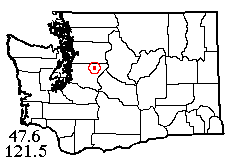 |
![]() 24 IX 2021: The idea was to climb Little Kid Mountain, hiking on a (we assumed) gated old road branching off Sunday Lake Trail near the head of the North Fork Snoqualmie River. The road appears on topo maps and online resources. So, on this beautiful warm day we reached the trailhead easily. Apparently everyone ignores the "entry by permit only" on a timber company sign at Gate 30; not far beyond is the regular Forest Service trailhead, then a precarious crossing of Sunday Creek Bog. In the section where our mountain road branches off, we somehow never spotted it, so we continued on across the grid line to a spot where it looked like we could get our lower-elevation sample.
24 IX 2021: The idea was to climb Little Kid Mountain, hiking on a (we assumed) gated old road branching off Sunday Lake Trail near the head of the North Fork Snoqualmie River. The road appears on topo maps and online resources. So, on this beautiful warm day we reached the trailhead easily. Apparently everyone ignores the "entry by permit only" on a timber company sign at Gate 30; not far beyond is the regular Forest Service trailhead, then a precarious crossing of Sunday Creek Bog. In the section where our mountain road branches off, we somehow never spotted it, so we continued on across the grid line to a spot where it looked like we could get our lower-elevation sample.
Thanks to the angle of sunlight, aerial webs were obvious and Laurel took 5 orbweaver species. I gathered a bag of alder litter but the siftable spiders were sparse; still relatively diverse though, with 7 species. They were even sparser in maple litter tried later, but every one of the 5 species in maple was different from the alder spiders! In between, Laurel used my sifter to get an excellent 16-species moss-sift sample. I added 3 more from fern understory, so we already had 34 species.
Hiking back, we kept our eyes open for the missing road. Ah, that looks like a road cut! But where's the road? It's gone entirely back to forest! Now mid-afternoon, no time to try brushwhacking up the mountain, so bag that. To supplement what we had so far, we returned to the car and drove to the valley part of the gridspace in order to find conifers for me to beat and a bridge for Laurel to collect from. Laurel found her bridge, crossing the North Fork near the end of the road and found 10 species on it, including two male Pelegrina aeneola jumping spiders that were fighting to the death! I didn't have such great luck with the conifers at this site, finding them poor pickings that only added 2 species; roadside grass added 2 more. But we still had a fine 45-species sample for the area, and a 2-year-old moss sample brings that to 48.
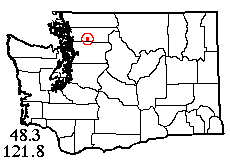 |
![]() 2 X 2021: There was just one area left to sample in the Cultus Mountains (a western outlier of the Cascades) of Skagit County. To reach it, we drove all the way up Finney Creek Road (surprisingly mostly paved) and turned off on forest road 18, which parallels Deer Creek. I had my eye on one of those dirt-roads-on-the-topo map, going by a nice pond and down to the creek; but driving by it, we saw no trace. On and on up #18, we finally stopped while I confirmed with my GPS that we were still in the area. We were, well inside, and our stopping place turned out to be excellent: alder-dominated forest below the road, while above was the best mature conifer stand in the vicinity, and a nice stream adjacent!
2 X 2021: There was just one area left to sample in the Cultus Mountains (a western outlier of the Cascades) of Skagit County. To reach it, we drove all the way up Finney Creek Road (surprisingly mostly paved) and turned off on forest road 18, which parallels Deer Creek. I had my eye on one of those dirt-roads-on-the-topo map, going by a nice pond and down to the creek; but driving by it, we saw no trace. On and on up #18, we finally stopped while I confirmed with my GPS that we were still in the area. We were, well inside, and our stopping place turned out to be excellent: alder-dominated forest below the road, while above was the best mature conifer stand in the vicinity, and a nice stream adjacent!
I began beating roadside hemlock foliage and it was so rich it was hard to stop, which I finally did with 14 species. Laurel sifted some moss from by the car and some from by the creek, and I independently followed the same strategy with alder litter; the litter added 11 and the moss, 6 more species including uncommon, undescribed Wubana #1. Only 3 habitats, and already we had 32 species! Roadside grass (wet, alas) had some impressive specimens but no more species. The roadside herbs were far too dew-wet to sweep, but Laurel found them ripe for hand-picking, and this added 8 more, one of them prey of another species.
Now I scrambled up into that mature conifer stand to try for a dead-wood sample. Despite the relatively low elevation, it worked out well; specimens kept coming and though we stopped when I had only 26 spiders, it did add a few species including uncommon Sisis rotundus. We started back a bit early anticipating dinner at the Burger Barn; little did we suspect that those perfidious short-order cooks were going to stop taking orders a full hour before their posted closing time! We did manage dinner (and even an ice-cream cone) at McDonald's, but Laurel's milkshake was a disaster! However, the main point of a field trip is spiders, and 43 species made the day well worth while.
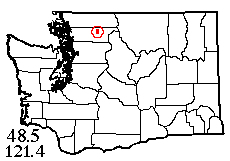 |
![]() 19 X 2021: After a 2-week wintry period, we finally got 2 more days of field weather! Unseasonably warm temperatures were forecast (but not quite realized) for the Marblemount area in the North Cascades, so we went for the Diobsud Creek (a name of obscure origin) plan. After prospecting one area full of unfriendly signs, we stopped just inside the national forest at the un-obvious trailhead for Diobsud Creek Trail. Hiking something under a mile, we found ourselves in a lovely area of reasonably old trees, big rocks, moss everywhere, fern-shrub understory, and a few maple trees: all the ingredients.
19 X 2021: After a 2-week wintry period, we finally got 2 more days of field weather! Unseasonably warm temperatures were forecast (but not quite realized) for the Marblemount area in the North Cascades, so we went for the Diobsud Creek (a name of obscure origin) plan. After prospecting one area full of unfriendly signs, we stopped just inside the national forest at the un-obvious trailhead for Diobsud Creek Trail. Hiking something under a mile, we found ourselves in a lovely area of reasonably old trees, big rocks, moss everywhere, fern-shrub understory, and a few maple trees: all the ingredients.
Of course I began sifting maple litter. Unexpectedly, not so rich in spiders! They were equally sparse in three different litter deposits, but though few in number, there were still 10 species there. Laurel sifted moss from trees and fallen "clods" from high branches, but found the spiders just as sparse; adding 8 species though, including her prized Ozyptila pacifica. Understory beating added 4, and the interesting factoid that Neriene radiata, sparse in western Washington, was dominant in this habitat. One more species from dead wood, and that was it: 22 in all. A bag of litter from the trailhead, brought home to warm up, added no more. And hiking out on the trail, I slipped and fell right on my trusty sifter, smashing it!
The Seattle city powerline we'd crossed on the way up was our main hope for more species and it didn't disappoint us. Eight species from grass-herb sweeping, a couple from Scots broom, and 12 from conifer foliage (plus one cross orbweaver in her web) brought us up to 37 for the day, although the Drassyllus, potentially the most interesting, were all juvenile. For all of that, still a successful trip. Our burger quest westward along Hwy. 20 yielded nothing open until we reached Burlington.
 |
![]() 31 X 2021: When our last October weather window fell on Halloween, Laurel decided we had to collect at a cemetery. So I came up with a couple of graveyard plans, but by the time we decided on one we'd already passed the turnoff. Our goal by default: Tornow Cemetery in Mason County south of Matlock. The topo map calls it Tornow, a sign on a log on-site just says "Grove" (not Grove Cemetery, just Grove) and Google mis-spells it Turnow. Since the Tornow family is buried there, I'll use that name. The best-known resident is John Tornow (1880-1913), the "Wild Man of the Wynoochee." Despite being Halloween, the cemetery was bright and sunny; an initially uncomfortable wind chill soon went away. While the dew dried, I beat conifer foliage all around the edge, getting 8 spider species and a harvestman. Laurel found 5 spider species and a different harvestman on tombstones. I added 3 species from salal and ferns plua 4 from broom, while Laurel found nothing mature under wood pieces and one single spider in Douglas-fir cones. We had only 16 species from the cemetery, but two more-natural sites nearby awaited us.
31 X 2021: When our last October weather window fell on Halloween, Laurel decided we had to collect at a cemetery. So I came up with a couple of graveyard plans, but by the time we decided on one we'd already passed the turnoff. Our goal by default: Tornow Cemetery in Mason County south of Matlock. The topo map calls it Tornow, a sign on a log on-site just says "Grove" (not Grove Cemetery, just Grove) and Google mis-spells it Turnow. Since the Tornow family is buried there, I'll use that name. The best-known resident is John Tornow (1880-1913), the "Wild Man of the Wynoochee." Despite being Halloween, the cemetery was bright and sunny; an initially uncomfortable wind chill soon went away. While the dew dried, I beat conifer foliage all around the edge, getting 8 spider species and a harvestman. Laurel found 5 spider species and a different harvestman on tombstones. I added 3 species from salal and ferns plua 4 from broom, while Laurel found nothing mature under wood pieces and one single spider in Douglas-fir cones. We had only 16 species from the cemetery, but two more-natural sites nearby awaited us.
Scott Prairie is on accessible Green Diamond land; it's one of those old-time prairies that grew over with forest under fire suppression, but recent logging restored it to a prairie-like grassland. I was able to sweep 9 species, but only three added to the cemetery sample. No prairie-specific species was mature, one disadvantage of the normally excellent fall collecting season. We'd parked in a tree aggregate left along a dry streamcourse, and that added more species: 7 from litter, 9 from maple trunk moss, 2 more from fallen moss clods, one from cones and 2 (the best 2) under wood. We left Scott Prairie with 35-36 species.
Not far off was a (presumably) historic wooden bridge, called Martins Bridge, over Decker Creek. Laurel spent our entire time there combing the large bridge for spiders, adding 4 species (and repeating 6 found elsewhere). Meanwhile, I sifted a gorgeous (but not very productive) pile of maple litter, beat a little understory, swept a little marsh grass, and finally beat some very good Douglas-fir foliage. Our bottom line was 42 species.
We've had successful field work all year. But then the record-breaking rains set in!
This page last updated 21 March, 2025